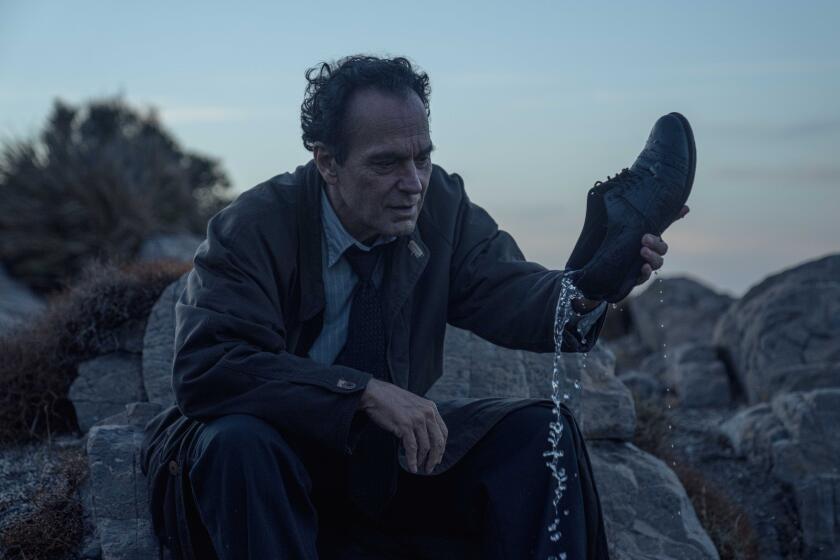More than talks
Some two decades ago, as this newspaper’s correspondent in South Africa, I watched apartheid crumble and Nelson Mandela walk free from prison. It was a reporter’s dream, covering the final gasps of an unjust system that was vilified around the world. And it had all the ingredients of a wonderful story, with courageous and malevolent characters on both sides.
“Endgame,” a British docu-drama on PBS this Sunday night, is an ambitious effort to turn the events leading up to that historic moment into a political thriller.
It’s an admirable film, not least because it so nicely portrays an important ingredient in South Africa’s success story: the face-to-face meetings between suspicious whites and leaders of the African National Congress that bridged a wide gulf of suspicion.
“Endgame” gets so many of the little things right, which is why it’s a shame that it mostly ignores the diverse array of events and actions that resulted in the end of apartheid. Like some other historical dramas, it imagines the momentous moment in South African history can be neatly traced back to the deeds of a few individuals.
We all know that strong characters make for strong and entertaining narratives. But “Endgame” focuses its lens so narrowly that its viewers might come away unaware that other, powerful forces inside and outside the country played a role in the end of apartheid. Those forces not only provided a context for change but arguably made it inevitable.
“Endgame” trains its spotlight on a series of talks between white Afrikaners and the ANC’s exiled leadership that were secretly launched outside London in late 1987 by Consolidated Goldfields, a British mining company with a deep financial interest in South Africa’s future.
Those dozen meetings were not the only meetings between whites in South Africa and the ANC in exile, but they were important because they included members of the Broederbond, the secret Afrikaner think tank with close ties to the white government. Broederbond members had been the original architects of the apartheid system. But by the late 1980s many were desperate for a way to end the policy of racial separation (and the country’s pariah status) without losing control of the country or protection for their cultural heritage.
The evolution of the relationship between Willie Esterhuyse, a leading Broederbond academic played by William Hurt, and Thabo Mbeki, the ANC’s international relations chief played by Chiwetel Ejiofor, are the heart of the film. The two men begin as wary adversaries and discover, over the conference room table but also over tumblers of fine Scotch, that they are bound together as South Africans with a common purpose.
“Endgame” viewers will conclude that those talks were not just important but pivotal. As the production’s press notes put it, the discussions at Mells House were the “miracle” that pulled South Africa from “the brink of catastrophe.”
The truth is that there were many pivotal moments that led to the downfall of apartheid. You can stretch a dinner party in Johannesburg until the wee hours by asking everyone present: What single event persuaded the white minority government to overcome its past and its fears and lift the ban on the ANC and free Mandela?
“Endgame” offers one answer, but the year that preceded Mandela’s 1990 release was full of other important events that contributed to the white government’s change of heart.
In defiance of the government, hundreds of white South Africans were traveling to ANC headquarters in Zambia and returning with the message that ANC leaders were reasonable people with whom they could do business.
At the same time, the collapse of communism in Eastern Europe moderated fears in South Africa about the ANC’s long and warm alliance with the South African Communist Party. Among other factors weighing on white South Africans were international sanctions. Although economic sanctions had never been particularly effective at changing hearts and minds, the country’s pariah status in the international sports world was deeply vexing.
But if there was a single pivotal event, a strong case can be made that it was fate. In early 1989, President P.W. Botha suffered a stroke and was replaced, in a close vote of the ruling National Party caucus, by F.W. de Klerk.
Ironically, De Klerk was regarded as the more conservative of the candidates for the job. But he surprised the world, and even many of his own National Party supporters, by quickly taking a series of steps that would lead to the end of white minority rule.
One of the early steps was to free Mandela’s fellow Rivonia Trial defendants in October 1989, after nearly a quarter-century in prison. Then, in February 1990, he lifted the ban on the ANC and all black political groups and, a week later, released Mandela.
One of the great debates in South African history is what led De Klerk to take those historic steps.
De Klerk told me several years later that, by the time he took over, he was convinced that apartheid was unworkable and that the survival of whites depended on granting the black majority a vote.
In his autobiography, De Klerk says he was kept informed of the Mells House discussions. But he was wary of independent talks with the ANC in exile.
Far more significant, he says, were the discussions that had taken place for several years between the government and Mandela in prison.
To De Klerk, Mandela -- not the talks between Mandela’s cohorts and Afrikaners in the English countryside -- was the key.
--
More to Read
Only good movies
Get the Indie Focus newsletter, Mark Olsen's weekly guide to the world of cinema.
You may occasionally receive promotional content from the Los Angeles Times.









